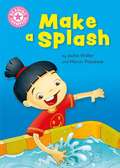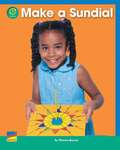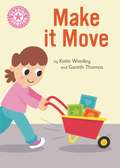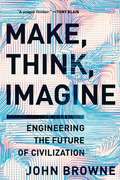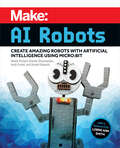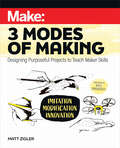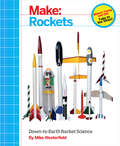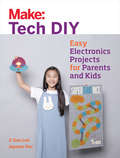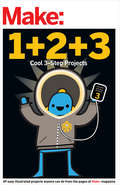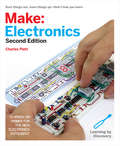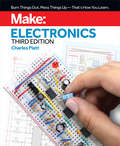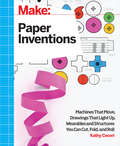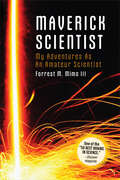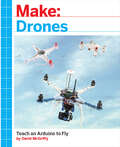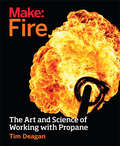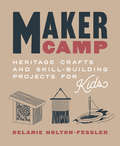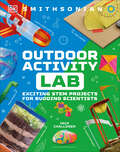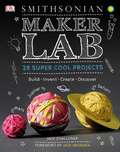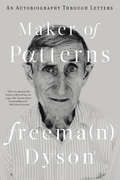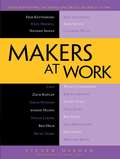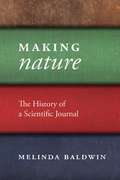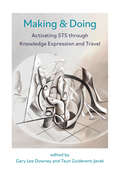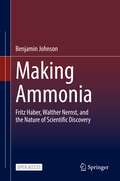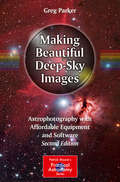- Table View
- List View
Make a Splash: Independent Reading Non-Fiction Pink 1a (Reading Champion #515)
by Jackie WalterThis book is part of Reading Champion, a series carefully linked to book bands to encourage independent reading skills, developed with UCL Institute of Education (IOE)Make a Splash is a non-fiction text exploring how different people can make a splash in water. The repeated sentence structure offers readers the opportunity for a very first independent reading experience with the support of the illustrations.Reading Champion offers independent reading books for children to practise and reinforce their developing reading skills.This early non-fiction text is accompanied by engaging artwork and a reading activity. Each book has been carefully graded so that it can be matched to a child's reading ability, encouraging reading for pleasure.
Make it Move: Independent Reading Pink 1B Non-fiction (Reading Champion #515)
by Katie WoolleyMake it Move is an informaiton book about pushing and pulling objects for children starting to learn to read. This book is part of Reading Champion, a series carefully linked to book bands to encourage independent reading skills, developed with Dr Sue Bodman and Glen Franklin of UCL Institute of Education (IOE)Reading Champion offers independent reading books for children to practise and reinforce their developing reading skills.Fantastic, original texts are accompanied by engaging artwork and a reading activity. Each book has been carefully graded so that it can be matched to a child's reading ability, encouraging reading for pleasure.
Make, Think, Imagine: Engineering The Future Of Civilization
by John BrowneAn impassioned defense of progress and innovation—and an argument for social responsibility from engineer, businessman, and former CEO of BP Lord John Browne. Today's unprecedented pace of change leaves many people wondering what new technologies are doing to our lives. Has social media robbed us of our privacy and fed us with false information? Are the decisions about our health, security and finances made by computer programs inexplicable and biased? Will these algorithms become so complex that we can no longer control them? Are robots going to take our jobs? Will better health care lead to an aging population which cannot be cared for? Can we provide housing for our ever-growing urban populations? And has our demand for energy driven the Earth's climate to the edge of catastrophe? John Browne argues that we need not and must not put the brakes on technological advance. Civilization is founded on engineering innovation; all progress stems from the human urge to make things and to shape the world around us, resulting in greater freedom, health and wealth for all. Drawing on history, his own experiences and conversations with many of today's great innovators, he uncovers the basis for all progress and its consequences, both good and bad. He argues compellingly that the same spark that triggers each innovation can be used to counter its negative consequences. Make, Think, Imagine provides an eloquent blueprint for how we can keep moving towards a brighter future.
Make: Create Amazing Robots with Artificial Intelligence Using micro:bit
by Reade Richard Brenda Shivanandan Andy Forest Denzel EdwardsArtificial intelligence is a tool to explore and create, and it starts here with the experts at Steamlabs, a nonprofit that teaches teens to not just be users of technology, but to create with technology so they can be help shape our future.Make: AI Robots introduces young people to AI through exciting craft projects that start with a mechanical cardboard creation, integrates fun electronic lights and motors, adds simple coding on a micro:bit, and then teaches how to train AI to create a spark of life.With 32 projects designed to guide beginners through increasing challenges, Make: AI Robots is the perfect way to feed curious minds with fun AI experiments that will delight and inspire.
Make: Designing Purposeful Projects to Teach Maker Skills
by Matt ZiglerThe Maker movement has been an excellent opportunity for people to become producers rather than just consumers, and schools are recognizing the value of offering students the tools, materials, and skills necessary to design sophisticated and meaningful projects. But teaching technical skills should not be the end goal: At its best, a Maker education teaches students to think and act in creative ways that can be applied to difficult challenges in all areas of life.Three Modes of Making provides a framework for Maker courses in upper grades that teach students creative-process skills through three key Maker modes: Imitation, Modification, and Innovation. Educators will learn the differences between the three Maker modes, their associated skill sets, and gain concrete methods to teach, document, and assess these skills. Through this approach, teachers will enable students to apply them to different creative needs.By focusing on how to teach skill development rather than merely how to build specific objects, Three Modes of Making enables students to improve and enhance their creative skills, and learn ways to apply them to a wide variety of challenges. This book is a road map to developing the creative problem solvers that the world needs for the future.
Make: Down-to-Earth Rocket Science
by Mike WesterfieldThis book teaches the reader to build rockets--powered by compressed air, water, and solid propellant--with the maximum possible fun, safety, and educational experience.Make: Rockets is for all the science geeks who look at the moon and try to figure out where Neil Armstrong walked, watch in awe as rockets lift off, and want to fly their own model rockets. Starting with the basics of rocket propulsion, readers will start out making rockets made from stuff lying around the house, and then move on up to air-, water-, and solid propellant-powered rockets. Most of the rockets in the book can be built from parts in the Estes Designer Special kit.
Make: Easy Electronics Projects for Parents and Kids
by Jaymes Dec Ji Sun LeeKid Crafts introduces younger children to the magic of electronics through the softer side of circuits! Young explorers will learn about electronics through sewing and craft projects aimed at maker parents and their children, elementary school teachers, and kids' activity leaders. Each project introduces new skills and new components in a progressive series of projects that take learners from the very basics to understanding how to use components such as sensors, transistors, and timers. The book is breezy, highly illustrated, and fun for everyone!
Make: From the Pages of Make:
by The Editors of Make:From the pages of Make: magazine comes this collection of dozens of projects you can make in your home or school workshop. You'll learn how to create toys and games from stuff you have lying around, create unusual and inspiring home improvements, and even find some new ways to have fun outdoors. You might even learn something along the way: electronics, flight, science, math, and engineering. In this book, you'll make:Batteries from everyday thingsBanana tattoosLED throwiesPiezo contact microphonePaper water bomberBox fan beef jerky
Make: Learning Through Discovery (Make Ser.)
by Charles Platt"This is teaching at its best!"--Hans Camenzind, inventor of the 555 timer (the world's most successful integrated circuit), and author of Much Ado About Almost Nothing: Man's Encounter with the Electron (Booklocker.com)"A fabulous book: well written, well paced, fun, and informative. I also love the sense of humor. It's very good at disarming the fear. And it's gorgeous. I'll be recommending this book highly."--Tom Igoe, author of Physical Computing and Making Things TalkA "magnificent and rewarding book. ... Every step of this structured instruction is expertly illustrated with photos and crisp diagrams. . . . This really is the best way to learn."--Kevin Kelly, in Cool ToolsThe first edition of Make: Electronics established a new benchmark for introductory texts. This second edition enhances that learning experience.Here you will find unique, photographically precise diagrams of breadboarded components, to help you build circuits with speed and precision. A new shopping guide and a simplified range of components, will minimize your investment in parts for the projects. A completely new section on the Arduino shows you how to write properly structured programs instead of just downloading other people's code. Projects have been reworked to provide additional features, and the book has been restructured to offer a step-by-step learning process that is as clear and visually pleasing on handheld devices as it is on paper. Full color is used throughout.As before, Make: Electronics begins with the basics. You'll see for yourself how components work--and what happens when they don't. You'll short out a battery and overheat an LED. You'll also open up a potentiometer and a relay to see what's inside. No other book gives you such an opportunity to learn from real-life experiences.Ultimately, you will build gadgets that have lasting value, and you'll have a complete understanding of how they work. From capacitors to transistors to microcontrollers--it's all here.Hans Camenzind, inventor of the 555 Timer (the world's most successful integrated circuit chip), said that "This is teaching at its best!" when he reviewed the first edition. Now the second edition offers even more!
Make: Learning by Discovery: A hands-on primer for the new electronics enthusiast
by Charles PlattMake: Electronics explores the properties and applications of discrete components that are the fundamental building blocks of circuit design. Understanding resistors, capacitors, transistors, inductors, diodes, and integrated circuit chips is essential even when using microcontrollers. Make: Electronics teaches the fundamentals and also provides advice on the tools and supplies that are necessary. Component kits are available, specifically developed for the third edition.
Make: Machines that Move, Drawings that Light Up, and Wearables and Structures You Can Cut, Fold, and Roll
by Kathy CeceriPaper is incredible stuff. It's easy to cut, but incredibly strong. It's disposable, but can last for centuries. It can stand as stiff as a board, pop up like a spring, or float like a leaf. And its invention changed the world forever. Perfect for kids, parents, and educators, Paper Inventions is a project-based book with full color illustrations, step-by-step instructions, supply lists, and templates that allow you to follow along with the book or devise something entirely new. Each chapter features new projects that will challenge and intrigue everyone, from beginning to experienced Makers. In this book, you'll learn to make: A light-up paper cat that shows how switches and sensors workAn action origami robot wormEdible rice paper perfect for secret messagesA space rover that moves thanks to paper machineryA paper generator that creates electricity when you tap or rub it Heat-activated paper models that fold themselvesA geodesic dome big enough to crawl into--from newspaper!
Make: My Adventures as an Amateur Scientist
by Forrest M. MimsMaverick Scientist is the memoir of Forrest Mims, who forged a distinguished scientific career despite having no academic training in science. Named one of the "50 Best Brains in Science" by Discover magazine, Forrest shares what sparked his childhood curiosity and relates a lifetime of improbable, dramatic, and occasionally outright dangerous experiences in the world of science.At thirteen he invented a new method of rocket control. At seventeen he designed and built an analog computer that could translate Russian into English and that the Smithsonian collected as an example of an early hobby computer. While majoring in government at Texas A&M University, Forrest created a hand-held, radar-like device to help guide the blind. And during his military service, he had to be given special clearance to do top secret laser research at the Air Force Weapons Lab. Why? Because while he lacked the required engineering degree, they wanted his outside-the-box thinking on the project.He went on to co-found MITS, Inc., producer of the first commercially successful personal computer, wrote a series of electronics books for Radio Shack that sold more than seven million copies, and designed the music synthesizer circuit that became known as the infamous Atari Punk Console. All this came before he started consulting for NASA's Goddard Space Flight Center, and NOAA's famous Mauna Loa Observatory, and earning the prestigious Rolex Award.This intimate portrait of a self-made scientist shares a revelatory look inside the scientific community, and tells the story of a lifelong learner who stood by his convictions even when pressured by the establishment to get in line with conventional wisdom. With dozens of personal photos and illustrations, Maverick Scientist serves as proof that to be a scientist, you simply need to do science.
Make: Teach an Arduino to Fly
by David McGriffyMake: Drones will help the widest possible audience understand how drones work by providing several DIY drone projects based on the world's most popular robot controller--the Arduino. The information imparted in this book will show Makers how to build better drones and be better drone pilots, and incidentally it will have applications in almost any robotics project. Why Arduino? Makers know Arduinos and their accessories, they are widely available and inexpensive, and there is strong community support. Open source flight-control code is available for Arduino, and flying is the hook that makes it exciting, even magical, for so many people. Arduino is not only a powerful board in its own right, but it's used as the controller of most inexpensive 3d printers, many desktop CNCs, and the majority of open source drone platforms.
Make: The Art and Science of Working with Propane
by Tim DeaganLearn how to safely build projects that burn, poof, "boosh," and flare! This complete reference and hands-on guide to working with propane explains how to create a variety of flame effects projects that can be built with common tools and materials.Starting from the basics, this book explains everything you need to know to safely work with propane. An essential reference for building projects like fire cannons, forge torches and flaming sculpture, Make: Fire explains the history, chemistry, and combustion of propane. Using that knowledge as a foundation, readers can then construct a variety of flame-based project on their own using illustrated, step-by-step instructions provided by the author. With simple tools, you can build a gorgeous flambeau, a torch capable of melting aluminum, or flame effects that ignite jaw-dropping fireballs in the sky. Focusing on safety at every step and written by a licensed Flame Effects Operator, this book provides information that has never been brought together in one place. With this guide, readers will master the fundamental components of almost all propane-based projects and develop the skills they need to create their own flame devices and artworks.
Maker Camp: Heritage Crafts and Skill-Building Projects for Kids
by Delanie Holton-FesslerClassic and innovative hands-on projects for kids ages 3 and up designed to teach both heritage skills and how to think creatively.Handcraft is part of human nature: we build, we create, we innovate. The 20+ projects in this book from an experienced art educator weave a story of human innovation and creativity, from the very beginnings of building shelters in the woods to tinkering with recycled materials. Heritage skills teach children how to be independent and capable makers; fiber and wood projects offer rewarding crafts that also teach planning, preparation, and safe risk taking; and tinkering activities connect the low-tech process of making and doing with innovation. From soap carving and knot tying to building toy cars and junk robots, this book brings the fun of making things with your hands to young kids and links skills of the past with the present. The book also explores how to set up a maker space and teaches foundational workshop practices that can easily be applied to the home studio. Each project offers extensions for different ages and abilities and provides guiding questions to enrich the experience for both the maker (teacher/parent) and the apprentice (child) to encourage and celebrate creative, practical play.
Maker Comics: Conduct a Science Experiment! (Maker Comics)
by Der-shing HelmerInside Maker Comics: Conduct a Science Experiment!, the latest volume of First Second's DIY graphic novel series, you'll find step-by-step instructions for six STEM projects.Reed’s moms are about to leave for a summer trip, and he can’t wait to spend his break playing games and making videos with his friends. But it turns out that after a year of suffering science grades, Reed’s parents have called in reinforcements: his big sister, Olive, who’s come home from college to help him out.At first, Reed’s furious to have to swap his internet time for summer school, but it turns out that science is more than just memorizing facts from books. Olive’s planned a jam-packed week of hands-on experiments, and bit by bit Reed has to admit that science can be kind of cool.
Maker Lab: 25 Super Cool Projects (DK Activity Lab)
by Jack ChallonerStep outside and discover the science that surrounds you!This fun, fact-filled book is brimming with exciting outdoor experiments to help budding scientists explore the science in their own surroundings. Using household items, construct a water rocket andblast it skywards to learn about air pressure, or blow giant, long-lasting bubbles to reveal howsurface tension works. Make a worm farm and observe worms tunneling, then build a diamond kite and discover the key to aerodynamics.Jam-packed with striking photography, step-by-step instructions, and rigorous attention to detail, Maker Lab: Outdoors will make young scientists excited from the get-go! Featuring a foreword by professor and scientist Robert Winston, the book gives a clear &‘how it works&’ explanation for each project, revealing the fascinating science behind it, along with real-world examples that show everyday science in action.So what are you waiting for? Grab your safety goggles and get stuck in to discover: - 25 outdoor experiments that appeal to young readers aged 9+ - All materials used are inexpensive and easy-to-find- Crystal-clear instructions are easy-to-follow- Educational mix of science-themed craft activities and experiments- Clear explanation of how and why each experiment worksMaker Lab: Outdoors is perfect for inspiring young scientists and outdoor enthusiasts to discover nature, weather, water, earth and sky. The real-world examples provide a context to better understand the scientific principles underlying each experiment young scientists and outdoor enthusiasts, this sensational science book for kids takes readers out of the house on a journey to better understand their world - and beyond.From the world of weather to water power, nature watching to giant bubbles, this is a must-have science book for every young scientist who is curious about their surroundings, with something for everyone to learn and love!
Maker Lab: 28 Super Cool Projects
by Dorling Kindersley StaffMaker Lab includes 28 kid-safe projects and crafts that will get young inventors' wheels turning and make science pure fun.
Maker of Patterns: An Autobiography Through Letters
by Freeman DysonBoth recalling his life story and recounting many of the major advances in twentieth-century science, a renowned physicist shares his autobiography through letters. While recognizing that quantum mechanics “demands serious attention,” Albert Einstein in 1926 admonished fellow physicist Max Born that the theory “does not bring us closer to the secrets of the Old One.” Aware that “there are deep mysteries that Nature intends to keep for herself,” Freeman Dyson, the 94-year-old theoretical physicist, has nonetheless chronicled the stories of those who were engaged in solving some of the most challenging quandaries of twentieth-century physics. Written between 1940 and the early 1980s, these letters to relatives form an historic account of modern science and its greatest players, including J. Robert Oppenheimer, Richard Feynman, Stephen Hawking, and Hans Bethe. Whether reflecting on the horrors of World War II, the moral dilemmas of nuclear development, the challenges of the space program, or the considerable demands of raising six children, Dyson offers a firsthand account of one of the greatest periods of scientific discovery of our modern age.
Makers at Work
by Steven OsbornWhat do you get when you combine an electronics hobbyist, hacker, garage mechanic, kitchen table inventor, tinkerer, and entrepreneur? A "maker," of course. Playful and creative, makers are--through expertise and experimentation--creating art, products, and processes that change the way we think and interact with the world. As you''ll see from the 21 interviews in Makers at Work, inquisitive makers are just as apt to pick up a laser cutter or an Arduino as a wrench to fashion something new. For example, you''ll meet Jeri Ellsworth, who might provide a video lecture on magnetic logic one day and a tutorial on welding a roll bar on a stock car the next. You''ll also meet Eben Upton, who put cheap, powerful computing in the hands of everyone with the Raspberry Π Becky Stern, who jazzes up clothing with sensors and LEDs; and bunnie Huang, who knows the ins and outs of the Shenzhen, China, electronics parts markets as well as anyone. As all the interviews in Makers at Work show, makers have something in common: reverence for our technical past coupled with an aversion to convention. If they can''t invent new processes or products, it''s simply not worth doing. Crazy as foxes, makers--working in the spirit of Tesla, Wozniak, Edison, Gates, Musk and many others--can bring sophisticated products to the people or to the market as fast or faster than large corporations. And they are not just enabling new technologies and devices--they are changing the way these devices are funded, manufactured, assembled, and delivered. Makers at Work puts a spotlight on the maker mindset and motivation of those who are reinventing the world one object or idea at a time. You will: Meet the individuals who define what it means to be a maker. Learn about the tools and technologies driving the new industrial revolution. Discover ways to scale your weekend project into a profitable business. See how others have used to crowdfunding to make their visions a reality. Learn how open-source hardware and software is enabling whole new categories of products by removing barriers of entry for inventors. The new masters of the "Makerverse" ask two questions: Can it be done? Is it fun? As these interviews will show, the answer to both questions is, "Let''s find out. " What you''ll learn You will: Learn about 3d printing and how it is changing manufacturing. Discover new software tools for designing things on your own. Learn how to source parts, code, or ideas for your creations. Meet maker pioneers who helped open up a new world, and makers who have used crowdfunding to support their efforts. Uncover recipes for success or failure when bringing physical products to market. Learn ways to scale your weekend project into a profitable business from experienced entrepreneurs. Learn how open-source hardware and software is enabling new classes of products by removing the barrier of entry for inventors. Open your mind to new ideas, methods, things, and possibilities. Who this book is for This book is for anyone with an independent spirit, creative bent, or natural curiosity who believes you can create whatever your mind can conceive and wants to see how others have done just that. Table of Contents Erik Kettenburg, Founder, Digistump David Merrill, Cofounder, Sifteo Nathan Seidle, CEO, SparkFun Electronics Laen, Founder, OSH Park Zach Kaplan, Founder and CEO, Inventables Emile Petrone, Founder, Tindie bunnie Huang, Founder, bunnie studios Natan Linder, Founder, FormLabs Ben Heck, Host, The Ben Heck Show Becky Stern, Director of Wearable Electronics, Adafruit Industries Eric Stackpole, Cofounder, OpenROV Eben Upton, Founder, Raspberry Pi Foundation Catarina Mota, Founder, OpenMaterials. org Ward Cunningham, Inventor, Wiki Jeri Ellsworth, Founder, Technical Illusions Sylvia Todd, Maker, Sylvia''s Super Awesome Maker Show! Dave Jones, Host, EEVBlog Bre Pettis, CEO, MakerBot Eric Migicovsky, CEO, Pebble Technology Ian Lesnet, Slashdot Troll, Dangerous Prototypes Massimo Banzi, Cofounder, Arduino
Making "Nature": The History of a Scientific Journal
by Melinda BaldwinMaking "Nature" is the first book to chronicle the foundation and development of Nature, one of the world's most influential scientific institutions. Now nearing its hundred and fiftieth year of publication, Nature is the international benchmark for scientific publication. Its contributors include Charles Darwin, Ernest Rutherford, and Stephen Hawking, and it has published many of the most important discoveries in the history of science, including articles on the structure of DNA, the discovery of the neutron, the first cloning of a mammal, and the human genome. But how did Nature become such an essential institution? In Making "Nature," Melinda Baldwin charts the rich history of this extraordinary publication from its foundation in 1869 to current debates about online publishing and open access. This pioneering study not only tells Nature's story but also sheds light on much larger questions about the history of science publishing, changes in scientific communication, and shifting notions of "scientific community. " Nature, as Baldwin demonstrates, helped define what science is and what it means to be a scientist.
Making & Doing: Activating STS through Knowledge Expression and Travel
by Gary Lee Downey and Teun Zuiderent-JerakHow ten making & doing projects expand STS scholarship through a focus on knowledge expression and knowledge travel in addition to knowledge production.Making & doing projects expand STS scholarship to include the trajectories of STS knowledge flow beyond the boundaries of the field by actively interweaving knowledge expression and travel with knowledge production. In this edited volume, contributors from around the world present and critically assess ten empirical making & doing projects. They recount how their projects advance STS, and describe how they themselves learn from their interlocutors and the settings in which they do and share their STS work. A coda explains how the infrastructures of STS scholarship are broadening to include practices of making & doing. The contributors examine and reflect upon their dilemmas, frustrations, and failures, especially when these generate new practices that might not have occurred had their work not taken the form of making and doing scholarship. While each project raises a distinct set of scholarly issues, all of the projects include practices that express STS knowledge through &“STS sensibilities&” and attach those sensibilities to practices in empirical fields. The ten projects include one each in Argentina, Taiwan, Canada, and Denmark; two in the US; one in Austria, the UK, and multiple countries in Africa and Asia; one in the US and Latin America; one in the Netherlands and Australia; and one in an international network that includes members from Europe, the Americas, and Australia.
Making Ammonia: Fritz Haber, Walther Nernst, and the Nature of Scientific Discovery
by Benjamin JohnsonThis Open Access book discusses the progress of science and the transfer of scientific knowledge to technological application. It also identifies the factors necessary to achieve this progress. Based on a case study of the physical chemist Fritz Haber's discovery of ammonia synthesis between 1903 and 1909, the book places Haber's work in historical and scientific (physicochemical) context. The scientific developments of the preceding century are framed in a way that emphasizes the confluence of knowledge needed for Haber's success. Against this background, Haber's work is presented in detail along with the indispensable contributions of his colleague, the physical chemist, Walter Nernst, and their assistants. The detailed accounts of scientific advancement remind us of the physical basis on which our scientific theories and ideas are built. Without this reminder we often forget how complex, and how beautiful achievements in science can be.
Making Beautiful Deep-Sky Images
by Greg ParkerThis book is based around the author's beautiful and sometimes awe-inspiring color images and mosaics of deep-sky objects. The book describes how similar "Hubble class" images can be created by amateur astronomers in their back garden using commercially available telescopes and CCD cameras. Subsequent processing and image enhancement in the "electronic darkroom" is covered in detail as well. A range of telescopes and equipment is considered, from the author's 11-inch with Hyperstar camera, down to more affordable instruments. Appendices provide links to free software - not available from a single source - and are themselves an invaluable resource.
